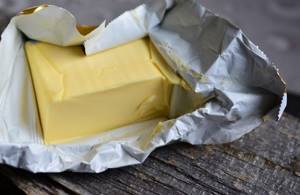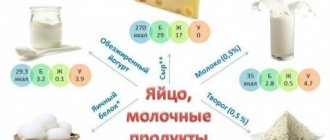When people think about weight loss, they think of fat as their biggest enemy. But not all fats are equal. Some of them are harmful and should be avoided, while others are beneficial and necessary for the body. Fat is an important macronutrient that regulates hormones, protects internal organs, gives the body energy and helps it better absorb certain vitamins and minerals. Let's figure out how much fat you need per day when losing weight.
What types of fats are there?
There are four types of fat. They have a very similar chemical structure, which consists of a chain of carbon atoms attached to hydrogen atoms. What differentiates them is the length and structure of the carbon chain, as well as the number of hydrogen atoms in it. The physical properties of the molecules of this nutrient and their effect on the body depend on these small details. That's why it's so important to know how much fat you need per day.
Unsaturated
Unsaturated fats are healthy. They are an essential component of any healthy diet. Not only are they the main source of energy, but they are also needed to create cell membranes and the protective layer that insulates nerves. They also help the body absorb important vitamins and minerals, and they are also needed for blood clotting, muscle movement, and fighting inflammation. Therefore, the question of how much fat the body needs for weight loss concerns specifically unsaturated options.
Monounsaturated and polyunsaturated are the two varieties. Avocados, nuts, olive oil and peanut oil contain monounsaturated fats.
Polyunsaturated fats are necessary for our body, and it cannot produce them itself. This means that you need to get them from food. The two main types of polyunsaturated fats are omega-3 and omega-6. What is their strength:
- they reduce bad cholesterol levels;
- reduce the risk of heart attack and stroke;
- in addition, they regulate serotonin levels, in other words, they are an antidepressant;
- stabilize hormonal levels during menopause and PMS.
Omega-3s are found in salmon, mackerel, sardines, flaxseeds and chestnuts. Vegetable oils: sunflower, soybean or corn are all sources of omega-6.
Saturated and trans fats
These are the bad guys. Saturated fats are found in beef, pork, dairy products such as whole milk, butter and cheese, as well as baked goods and processed foods.
The body produces saturated fat itself, so it does not need it from external sources. Then how many grams of such fat can you consume per day when losing weight?
Scientific studies have shown that a diet rich in such fat raised cholesterol levels and could even cause blocked arteries. It is not necessary to avoid it completely, but you should try to reduce the amount of this particular type in your diet.
Trans fats are the most harmful type, they have no beneficial properties, and even in small doses they will only cause harm. They are artificial, used to enhance shelf life, and are often found in fried restaurant foods and snacks. This fat is a byproduct of the hydrogenation process, which turns healthy oils into a solid state so they don't go rancid.
Such hydrogenated oils have even been banned in some countries. They raise cholesterol levels and cause inflammation, which increases the risk of problems such as heart disease, diabetes and stroke. And in some semi-finished products you can find traces of such fats, even if the label of a product says that it does not contain them, this does not always mean that this is true.

What happens if you completely eliminate fats?
The widespread misconception among incompetent people that you can get rid of excess weight by completely eliminating foods containing fats from your diet can cause irreparable harm to a person.
Namely:
- Without lipids, the body cannot absorb vitamins and microelements. Vitamin deficiency and lack of calcium and magnesium lead to serious cosmetic defects: wrinkles, sagging skin, fragility and hair loss, splitting of nails.
- Fat deficiency can cause hormonal imbalances and weakened immunity.
- The exclusion of lipid components from the physiological process in a living organism can cause problems in any of its systems.
- The change in metabolism provoked by the elimination of lipids ultimately leads to the opposite result: the body feels a lack of fats and begins to store them in its “storage areas”.
Fats have a high energy value, and products containing them are very high in calories, so sanctions against excess weight are primarily directed against them.
This is not only unfair, but also harmful, just like overuse. Therefore, it is reasonable to find a “golden mean”: adhere to the daily norm, and consume mainly vegetable fats.
Recommended daily amount
How much fat do you need per day? Doctors say that of all the calories eaten per day, 25% to 35% should come from fat, which is 400-700 Kcal if we eat only 2000 calories per day. One gram of fat costs you 9 calories, which means you should eat between 44 and 78 grams of fat per day.
Let's remember how much fat you need per 1 kg of weight. For 1 kg of weight you need to consume 1 g of fat, if you do not have problems with excess weight. If you decide that the hour has come and it’s time to lose a few kilograms, then expect to consume only 0.7 g per 1 kg of weight.
Consumption of fat replaces carbohydrates
The total percentage of macros in your diet should be 100 percent. Increasing your intake of one macro means you need to reduce your intake of others. Whatever your goal—be it fat loss, muscle hypertrophy, or performance enhancement—you must first meet your protein needs and then tailor your fat and carbohydrate intake accordingly.
Consuming more fat means consuming fewer carbohydrates, and vice versa. From a fat-burning perspective, displacing carbohydrates by increasing fat in your diet creates the basis for an optimal fat-burning environment. Insulin, released by the body in an amount proportional to the amount of carbohydrates you consume, is one of the main factors in the distribution of nutrients to the various needs of the body. Lower insulin levels—achieved by lowering your carbohydrate intake—will allow your body to more easily use fat stores for energy, and make it easier for your muscles to take in and use fat for fuel.
How much fat does a person need per day?
Recommended daily intake based on calories eaten
Calories Calories from Fat Grams
1200 240-420 27-47
1500 300-525 33-58
1800 360-630 40-70
2000 400-700 44-78
2200 440-770 49-86
The table shows how many grams of fat you need per day. The recommended amount includes all fats in your diet, whether they are healthy or not. But it's best if all the fat you eat is polyunsaturated and monounsaturated. Experts say that 15 to 20% of all calories eaten per day should come from monounsaturated fats, 5 to 10% from polyunsaturated fats, less than 10% from saturated fats and 0% from trans fats.
How much fat do you need per day when losing weight? Remove 30% from the daily value from the table. This will be your norm when losing weight. Try to cut down on the saturated ones. For example, if you want to eat 100 grams of cheese, you will have to cut this piece by 30% and eat not 100 grams, but 70 grams.
Daily protein intake
The standard daily protein intake is calculated based on weight. For every kilogram of weight there should be one and a half grams of proteins, and at least a third of them should be of animal origin.
For men:
| Labor intensity | Age and amount of protein |
| Mental | 18-29 years old Total: 91 g Including animal origin: 50 g |
| 30-39 years old Total: 88 g Including animal origin: 48 g | |
| 40-59 years old Total: 83 g Including animal origin: 46 g | |
| Light physical | 18-29 years old Total: 90 Including those of animal origin: 49 |
| 30-39 years old Total: 87 g Including animal origin: 48 g | |
| 40-59 years old Total: 82 g Including animal origin: 45 g | |
| Medium hard work | 18-29 years old Total: 96 g Including animal origin: 53 g |
| 30-39 years old Total: 93 g Including animal origin: 51 g | |
| 40-59 years old Total: 88 g Including animal origin: 48 g | |
| Heavy | 18-29 years old Total: 102 g Including animal origin: 56 g |
| 30-39 years old Total: 99 g Including animal origin: 54 g | |
| 40-59 years old Total: 105 g Including animal origin: 52 g | |
| Particularly heavy | 18-29 years old Total: 118 g Including animal origin: 65 g |
| 30-39 years old Total: 113 g Including animal origin: 62 g | |
| 40-59 years old Total: 107 g Including animal origin: 59 g |
For women:
| Labor intensity | Age and amount of protein in g |
| Mental | 18-29 years old Total: 78 g Including animal origin: 43 g |
| 30-39 years old Total: 75 g Including animal origin: 41 g | |
| 40-59 years old Total: 72 g Including animal origin: 40 g | |
| Light physical | 18-29 years old Total: 77 g Including animal origin: 42 g |
| 30-39 years old Total: 74 g Including animal origin: 41 g | |
| 40-59 years old Total: 70 g Including animal origin: 39 g | |
| Medium hard work | 18-29 years old Total: 81 g Including animal origin: 45 g |
| 30-39 years old Total: 78 g Including animal origin: 43 g | |
| 40-59 years old Total: 75 g Including animal origin: 41 g | |
| Heavy | 18-29 years old Total: 87 g Including animal origin: 48 g |
| 30-39 years old Total: 84 g Including animal origin: 46 g | |
| 40-59 years old Total: 80 g Including animal origin: 44 g |
BZHU table: norms for weight loss
To effectively lose weight, it is not at all necessary to starve and make yourself a bunch of diseases, it is enough to observe a rational ratio of BZHU.
As already noted, the proportion of BZHU looks like 1:1:4. But in order to achieve results in weight loss, in this ratio it is necessary to increase the proportion of proteins by reducing the proportion of carbohydrates.
Thus, the classic formula is transformed into a 5:1:2 ratio. It should be borne in mind that in addition to following a balanced diet, systematic physical activity plays an important role in achieving a guaranteed result.
For men:
| Labor intensity | Age and quantity in grams |
| Mental | 18-29 years old Total proteins: 358 g Including animal origin: 119 g Fat: 71 g Carbohydrates: 143 g |
| 30-39 years old Total proteins: 345 g Including animal origin: 115 g Fat: 69 g Carbohydrates: 138 g | |
| 40-59 years old Total proteins: 325 g Including animal origin: 108 g Fat: 65 g Carbohydrates: 130 g | |
| Light physical | 18-29 years old Total proteins: 383 g Including animal origin: 128 g Fat: 76 g Carbohydrates: 153 g |
| 30-39 years old Total proteins: 370 g Including animal origin: 123 g Fat: 74 g Carbohydrates: 148 g | |
| 40-59 years old Total proteins: 351 g Including animal origin: 117 g Fat: 70 g Carbohydrates: 140 g | |
| Medium hard work | 18-29 years old Total proteins: 408 g Including animal origin: 136 g Fat: 82 g Carbohydrates: 163 g |
| 30-39 years old Total proteins: 396 g Including animal origin: 132 g Fat: 79 g Carbohydrates: 158 g | |
| 40-59 years old Total proteins: 376 g Including animal origin: 125 g Fat: 75 g Carbohydrates: 151 g | |
| Heavy | 18-29 years old Total proteins: 473 g Including animal origin: 158 g Fat: 95 g Carbohydrates: 188 g |
| 30-39 years old Total proteins: 459 g Including animal origin: 153 g Fat: 92 g Carbohydrates: 184 g | |
| 40-59 years old Total proteins: 446 g Including animal origin: 149 g Fat: 89 g Carbohydrates: 179 g | |
| Particularly heavy | 18-29 years old Total proteins: 549 g Including animal origin: 183 g Fat: 110 g Carbohydrates: 219 g |
| 30-39 years old Total proteins: 523 g Including animal origin: 174 g Fat: 105 g Carbohydrates: 209 g | |
| 40-59 years old Total proteins: 498 g Including animal origin: 166 g Fat: 100 g Carbohydrates: 198 g |
For women:
| Labor intensity | Age and quantity |
| Mental | 18-29 years old Total proteins: 306 g Including animal origin: 102 g Fat: 61 g Carbohydrates: 123 g |
| 30-39 years old Total proteins: 293 g Including animal origin: 98 g Fat: 59 g Carbohydrates: 117 g | |
| 40-59 years old Total proteins: 281 g Including animal origin: 94 g Fat: 56 g Carbohydrates: 113 g | |
| Light physical | 18-29 years old Total proteins: 326 g Including animal origin: 109 g Fat: 65 g Carbohydrates: 130 g |
| 30-39 years old Total proteins: 313 g Including animal origin: 104 g Fat: 63 g Carbohydrates: 125 g | |
| 40-59 years old Total proteins: 299 g Including animal origin: 100 g Fat: 60 g Carbohydrates: 120 g | |
| Medium in severity | 18-29 years old Total proteins: 344 g Including animal origin: 115 g Fat: 69 g Carbohydrates: 138 g |
| 30-39 years old Total proteins: 332 g Including animal origin: 111 g Fat: 66 g Carbohydrates: 133 g | |
| 40-59 years old Total proteins: 319 g Including animal origin: 106 g Fat: 64 g Carbohydrates: 128 g | |
| Heavy | 18-29 years old Total proteins: 404 g Including animal origin: 135 g Fat: 81 g Carbohydrates: 161 g |
| 30-39 years old Total proteins: 389 g Including animal origin: 133 g Fat: 78 g Carbohydrates: 156 g | |
| 40-59 years old Total proteins: 370 g Including animal origin: 123 g Fat: 74 g Carbohydrates: 148 g |
This proportion, like all others, is very relative. Each organism is individual, so there are no universal standards for it. Therefore, if you have chosen the method of calculating BJU to lose weight, take the proposed ratio as a basis and adjust it in practice based on your characteristics.
Fat and weight loss
Fats are very high in energy, containing twice as many calories as carbohydrates and proteins. Because of this, a diet high in them can cause excess weight, because the body stores extra calories that are not burned. It's important to remember how much of this nutrient we eat, and it's equally important to know what type it is.
If you want to know how much fat girls need per day when losing weight, then this is approximately 25% of the total calories. Calculate how many total calories you consume and compare the amount you need.
Healthy amounts of monounsaturated and polyunsaturated types help you lose weight because they promote a feeling of fullness. Unlike other types of food, such as carbohydrates, which increase appetite, food with unsaturated fat, on the contrary, reduces it.
Delicious foods such as cheese, cakes, biscuits, ice cream, crackers, sausages, bacon and fries often contain saturated and trans fats. These foods activate pleasure levers that further increase our appetite, causing us to eat more than we should. Such foods should be removed from the diet altogether.
So, how many grams of fat per 1 kg of weight are needed for weight loss:
- for men 0.5 g per 1 kg of weight;
- for women 0.7 g per 1 kg of weight.

What is BJU?
BJU stands for proteins, fats, carbohydrates and is often used in publications by nutritionists. This is understandable, because all three components serve as sources of energy for the human body, and energy balance, in turn, is the key to competent and effective weight loss.
If there is an excess amount of one element or another in the diet, and the body does not have time to spend the energy received, it is converted into lipid tissue and stored as a reserve under the skin.
Therefore, for the most rational diet, the classic BJU ratio is considered to be 1:1:4.
For a person engaged primarily in physical labor, the proportions of BJU are somewhat transformed and look like 1:1.3:5.1. The longer and more intense the load, the more caloric the food should be.
Why does the female body love fats?
This is associated with reproductive function. Nature decided that a woman should think not only about herself, but also about how to bear and feed her offspring. And a lean male hunter must supply her with provisions. Therefore, the normal percentage of fat in a woman’s body is 20%, and in a man’s body it is 8-10%.
The second reason why there are 25% more obese women than obese men is that women are more emotional. They love to eat everything: stress, depression, buying a new handbag. Scientists have also found that willpower in the weaker sex is inferior to that of men.
But women don’t eat it with a spoon. Agree, it’s difficult to just eat a 20 gram block of butter. But if you spread it on a freshly baked wheat bun with a crispy crust or put it on boiled fresh potatoes sprinkled with dill, then with such gastronomic accompaniment we will gladly eat not only these 20 g of butter, but also all 50 g.
And what can we say about cakes and donuts with cream? Who can resist? Therefore, we always keep in mind how much fat you need to consume per day to lose weight - 0.7 g per 1 kg of weight, and more than one cake.
Interesting fact: 90% of women, when choosing sex VS a piece of cake, will choose cake.
Features of adipose tissue
What do we know about fat? Well, probably the fact that it insidiously tries to cover the entire body, especially the so-called “problem areas”, that the fight against it is exhausting and often hopeless. No matter how hard it takes to lose those extra pounds, they immediately strive to come back, and in even greater quantities.
Why do efforts often remain fruitless? To answer this question, it is necessary to understand how adipose tissue is structured, what role it plays in the body, and whether it is really necessary to try to destroy it. Knowledge of the laws of formation and development of adipose tissue is necessary for everyone who is seriously involved in the problems of weight and figure correction.
There is a fundamental difference between the treatment of obesity as a disease that causes significant harm to health, which is carried out by medical specialists, and the correction of defects in appearance. If a woman doesn’t like her figure because “it hangs too much here and sticks out here,” then no doctor will consider it a disease. From a medical point of view, the patient is healthy. But has anyone calculated how much suffering unaesthetic mounds, saggy lumps of fat and other “decorations” cause women? In this case, a cosmetologist is the only specialist who can help. He will be able to select an individual program that will eliminate both cosmetic imperfections and help improve tissue health - muscles, fatty tissue, skin.
What cells does adipose tissue consist of?
Adipose tissue consists of fat cells - adipocytes , located in groups in loose connective tissue. (“Adipo” (Latin) and “lipo” (Greek) mean fat). The adipocyte consists of one large drop of fat, pushing the nucleus and other organs of the cell to the periphery.
The amount of fat in white adipose tissue can reach up to 85%. An unpleasant property of adipocytes is their ability to quickly increase in volume. Their diameter can increase by 27-40 times (!).
In addition to adipocytes, adipose tissue contains cells that are precursors of adipose tissue - preadipocytes. It has long been believed that the number of adipocytes does not change after puberty. Indeed, a mature adipocyte loses its ability to reproduce. But, unfortunately, the so-called preadipocytes are capable of turning into adipocytes. (At the moment, these cells are not well studied). Thus, at any age, it is possible to increase the number of fat cells due to poor nutrition or hormonal imbalances .
There are not many vessels in adipose tissue, but every healthy fat cell is in contact with at least one capillary. Thus, various substances enter the cell and decay products are removed. With obesity and cellulite, not every cell is connected to a capillary, which leads to slagging of adipose tissue with metabolic products.










